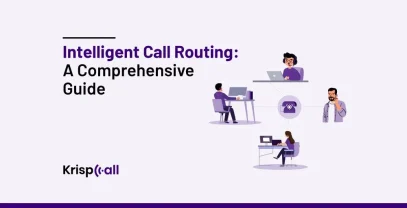Are you struggling😥 to meet your sales targets? Feeling overpowered by the complexities of sales planning?
Sales planning is the backbone of any successful sales operation, which includes everything from goal-setting to putting growth-oriented strategies into action.
Look no further! In this post, you will learn how to make the best sales plan for your business and the tools you need to be successful.
🔑 Key Points
- Sales planning is crucial for achieving sales targets, providing a roadmap from goal-setting to implementing growth-oriented strategies.
- A 30-60-90 day sales plan outlines goals, objectives, and tasks for a salesperson in the first 30, 60, and 90 days of a new position.
- The role of a sales plan in a business includes clearly defining goals, providing strategic direction, measuring performance, motivating the team, and aligning sales efforts with business objectives.
- Common mistakes in the sales planning process include lack of research, goal misalignment, setting unrealistic goals, poor communication, neglecting training, and ignoring feedback.
- KrispCall enables sales teams to review conversations and identify areas for improvement, as well as understand customer pain points and objections.
What is a sales plan?
A sales plan is a strategic document that lists the goals, target market, sales techniques, and methods a firm hopes to use to accomplish its sales targets. A thorough examination of the present state of sales and the goals, projections, and plans of action for reaching those goals are usually included.

A firm with a well-developed business plan finds it easier to assess its progress toward sales targets, coordinate its sales teams, and concentrate its resources. It also helps the sales leaders discover possibilities and possible obstacles in the market by acting as a roadmap.
What is the importance of a well-mapped sales plan in a business?
A well-mapped sales plan is like a blueprint for success in any business. It’s vital for several reasons:
- Focus and Clarity: It gives your sales staff a clear path by defining objectives, target markets, tactics, and resources. Confusion is removed, and everyone can concentrate on the appropriate tasks, which boosts production and efficiency.
- Strategic Path: A sales strategy is essential for a corporation to map out its route to success, just as a ship requires one to sail the oceans. Every sales team member will know where they’re going and how they’re going to get there since it defines the direction by clearly articulating objectives and tactics.
- Effectiveness & Efficiency: A sales strategy helps the sales team operate more productively by providing distinct strategies and methods. They can more efficiently manage their time and resources, focusing on the most promising prospects and increasing their chances of success.
- Improved Interactions with Customers: With a well-defined strategy, your sales staff can interact with clients more successfully, comprehend their needs more fully, and present solutions that support their objectives. More enduring bonds and recurring business result from this.
- Increase motivation: Your sales staff may be very motivated by a well-defined and realistic plan. Setting expectations, giving people a sense of direction, and enabling them to monitor their progress toward common objectives all serve to increase motivation and morale.
What are the types of sales plans?
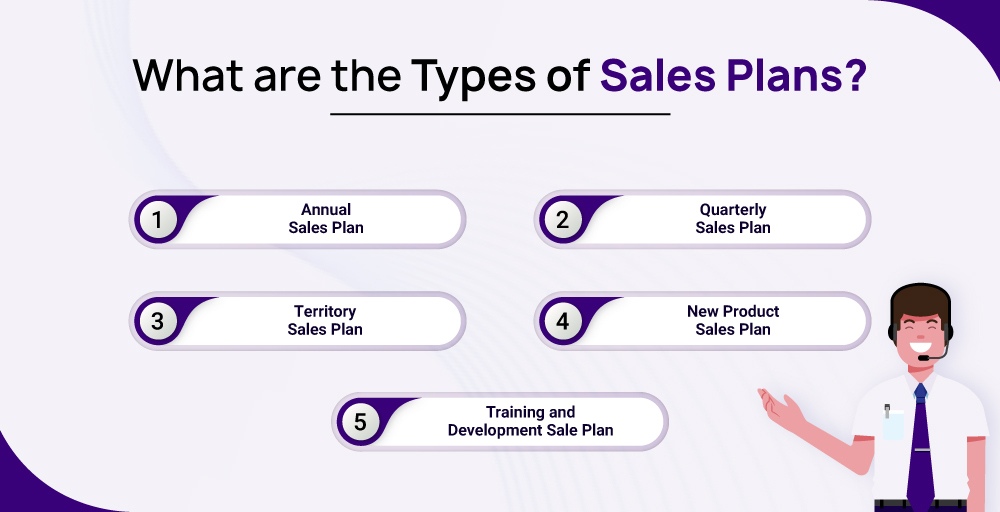
There are several types of sales plans, some of which are as follows:
1. Annual Sales Plan
This is a detailed strategy that describes the goals, approaches, and methods for sales for the whole fiscal year. Usually, it comprises specific goals for profit, market share, and client acquisition, together with the resources required to reach them. The sales leaders follow the yearly sales strategies as a guide throughout the year.
2. Quarterly Sales Plan
Comparable to the yearly sales plan, but with a three-month timeframe of concentration instead of a year. Businesses may divide their yearly goals into smaller, more achievable segments by using quarterly sales strategies. They also allow you to change your plans and approaches more regularly in response to shifting market conditions.
3. Territory Sales Plan
Territorial sales plans represent the goals, approaches, and techniques for each distinct sales territory in companies that employ regional or territorial sales teams. Sales efforts are customized to meet the unique requirements of each region by taking into consideration variables including consumer demographics, market size, competition, and geographic location.
4. New Product Sales Plan
This kind of sales plan is designed specifically for the introduction of a new product or service. It describes the launch-related sales goals, target market, messaging, price strategy, and promotional activities. Product launch strategies are essential for creating buzz and boosting early sales of new products.
5. Training and Development Sale Plan
The training and development requirements of the sales staff are the main emphasis of this kind of sales strategy. It describes what salespeople must know, be able to do, and be competent in addition to the company’s training courses, tools, and after-sale support systems.
What is a 30-60-90 day sales Plan?
A 30-60-90 day sales plan is a strategic plan that outlines the goals, objectives, and tasks a salesperson has to complete in the first 30, 60, and 90 days after starting a new position or entering a new sales area. It’s frequently utilized as a method for integrating new sales teams or those moving up the corporate ladder.
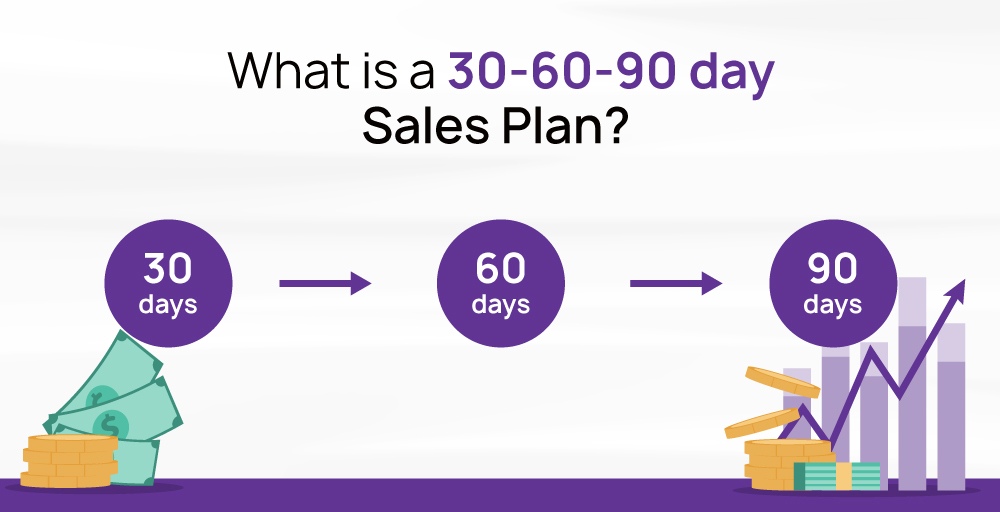
During the first thirty days, learning about the goods and services, comprehending the market, and cultivating customer connections can be the main priorities.
During the next thirty days, the focus usually switches to putting sales methods like networking and prospecting into action.
Lastly, during the final 30 days, the plan can call for adjusting strategies, evaluating results, and establishing longer-term objectives. Sales professionals may use the plan as a guide to show that they understand the business, establish realistic goals, and monitor their success in their new position.
What are the best sales strategies and practices?
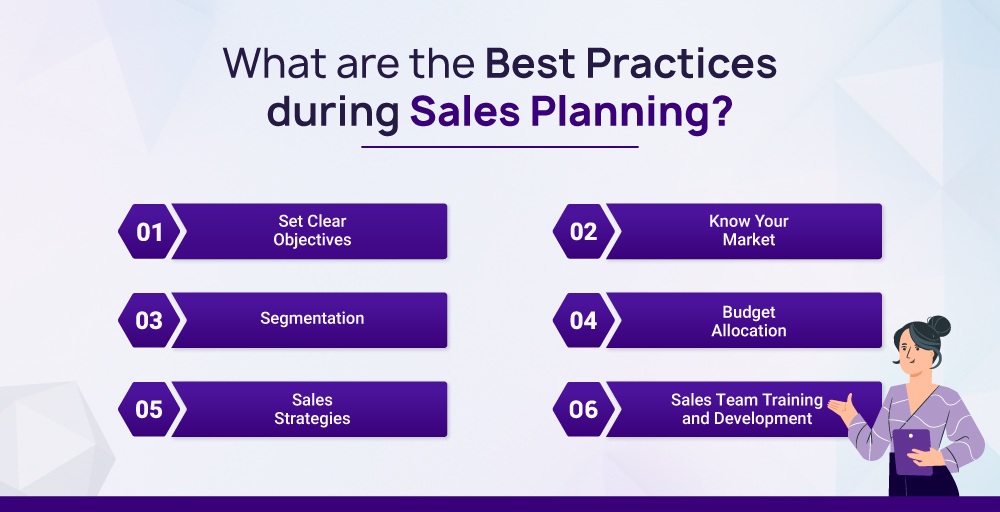
Data analysis, strategic thinking, and efficient execution are all components of sales planning. The following are some recommended procedures to think about:
1. Set Clear Objectives
Having a clear idea of your goals is essential before you start any kind of sales strategy. These goals have to be SMART—specific, measurable, realistic, relevant, and time-bound. For instance, your goal can be to add new clients in the next six months or to grow sales income in the upcoming quarter.
2. Know Your Market
A key component of an effective sales strategy is knowing your target market. This includes studying rivals, market trends, psychographics, and demography. You may adjust your sales techniques to more effectively address the demands, pain areas, and preferences of your consumers by learning about them.
3. Segmentation
You should divide up your consumer base according to shared traits or habits because not all customers are the same. Your ability to create messages and sales tactics that are relevant to each category is facilitated by this segmentation. You may, for instance, divide up your market into segments according to purchase patterns, firm sizes, industries, or locations.
4. Budget Allocation
After determining your sales goals and projecting your revenues, you must allocate resources appropriately. Budgeting for the sales team, marketing campaigns, technology purchases, and any other resources required to assist with your sales activities are all included in this. Investments should be ranked in order of possible return on investment (ROI) and alignment with your sales goals.
5. Sales Strategies
Depending on your goals, target market, and sector, you may use a variety of sales techniques. They might be channel partnerships, account-based selling, outbound prospecting, inbound marketing, or e-commerce sales. Select the tactics that most closely fit your objectives and the conditions of the market, and be ready to modify them as necessary.
6. Sales Team Training and Development
You must make training and development investments for your sales team because they are the source of your company’s income. To help your salespeople thrive, provide them with regular coaching, courses for skill development, and product knowledge sessions. Promote an environment where learning and development are ongoing processes in your sales team.
Tips For Creating an Effective Sales Strategy
Discover some tips and tricks for developing a business strategy that will enable you to surpass the expectations of your superiors and meet your goals
- To strengthen your sales plan, take industry trends into account. Use market trends to highlight the efficacy of your strategy while presenting your sales plan to stakeholders
- Give an overview of the technology you plan to use to track progress. This can function as a manual for yourself or as a way to explain your success measurement techniques to stakeholders. Software for dashboards and CRM systems are two examples of technologies to consider.
- Support your budget plan with specific figures and information. If your strategy includes creating a budget, support it with sales projections and previous performance information.
- Make unique plans for every squad. You may further define and hone your objectives and key performance indicators (KPIs) by creating unique sales plans for inbound sales, field sales, outbound sales, business development, and other teams.
- Talk to the marketing staff for suggestions. Your sales plan’s performance depends on marketing and sales working together. Your lead generation, prospecting, and nurturing efforts may be more effectively coordinated if you include marketing.
- Make sure you analyze the competition in depth. To create a strategy that moves your business in the same direction, you must first understand what makes your competition successful.
How to Implement a Sales Plan in Your Business?
The execution of a sales plan requires careful planning and collaboration between several business units. The following is a step-by-step guide for implementing a sales plan:
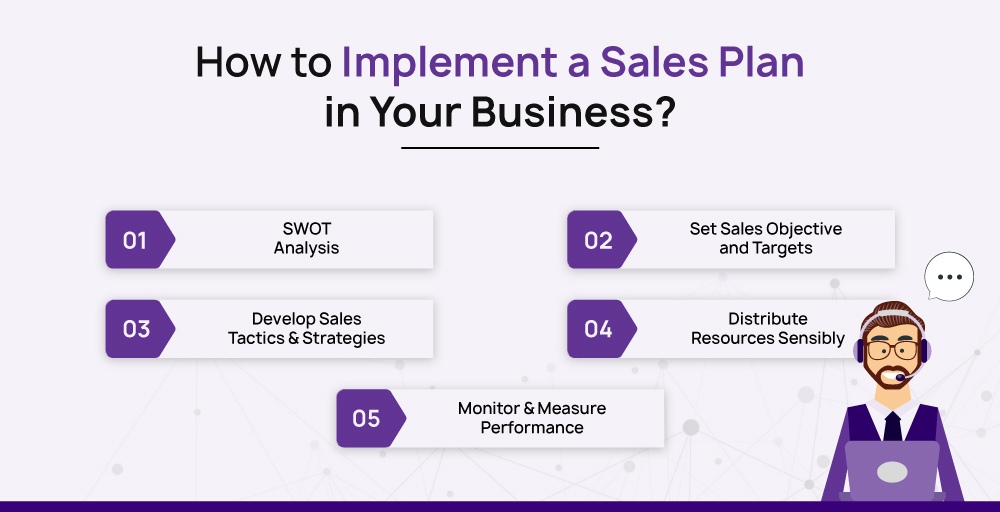
1. SWOT analysis
A SWOT analysis considers external elements like market opportunities and threats and internal elements like your company’s strengths and weaknesses. This evaluation aids in understanding the current state of your company and projecting future trends.
Note down important aspects that are influencing your sales process at this point, such as the competitive climate, market trends, consumer demographics and preferences, technical developments, regulatory considerations, and other internal and external environmental effects.
2. Set sales objectives and Targets
Divide the sales plan into manageable, quantifiable goals for each member of the team. Make sure these goals are in line with the overarching objectives of the company, reasonable, and attainable. Assessing progress and inspiring the team by giving regular feedback and performance reviews is important.
3. Develop Sales Tactics and Strategies
Develop comprehensive plans and techniques for accomplishing sales goals in collaboration with the sales manager and team. Determine your target markets, market niches, and clientele, then adjust your sales strategies appropriately. To create leads and complete transactions, use a combination of cold calling, networking, prospecting, presentations, and follow-up activities.
4. Distribute Resources Sensibly
Allocate resources according to the sales plan’s priorities, including people, time, budget, and technology. Make sure that funds are used wisely to support sales initiatives, including relationship building, lead generation, and client acquisition.
5. Monitor and Measure Performance
Keep an eye on and evaluate sales performance based on the goals and KPIs specified in the sales strategy. To monitor development, spot patterns, and discover areas for improvement, use data analytics and reporting technologies. Review performance metrics with the sales team regularly, and make any adjustments to tactics and strategies.
How to use sales planning templates?
Sales planning templates expedite the procedure and guarantee that all necessary elements are covered. To make the most of them, choose a sales plan template that is in line with your company objectives, make the necessary adjustments, and collect important information.
Use the structure that has been provided to organize your plan, making sure that your goals and methods are realistic and detailed. Include stakeholders in the process of providing comments and reviews, and revisit and revise the strategy regularly in light of market and performance developments.
Spread the word about the strategy and put it into action. Keep an eye on things and be ready to adjust the course if necessary. With these steps, you may create a thorough sales forecast that propels your company’s success.
What are the most common mistakes made in the sales planning process?
Here are some elaborations on each of the common mistakes in the sales planning process:
1. Lack of Research
A thorough understanding of consumer preferences, rival tactics, and market trends can only be obtained through extensive market research. A sales strategy could undervalue difficulties or overlook important possibilities without this basis.
2. Overlooking Goal Alignment
Broader company objectives like revenue targets, market expansion, or brand positioning should be supported by sales activities. Resources may be squandered and efforts may become dispersed if sales plans are not in line with these broad goals.
3. Setting Unrealistic Goals
Although setting high standards for yourself might be inspiring, be sure they are realistic. Sales teams may get demoralized by unrealistically high objectives, which may result in disengagement or burnout. Establishing objectives that are both attainable and difficult promotes consistent effort and advancement.
4. Poor Communication
Coordination and alignment within the company are ensured by effective communication between sales teams and other divisions. Key insights might be missed, and cooperative efforts could suffer in the absence of effective communication channels.
5. Neglecting Training and Development
For sales teams to remain flexible and competitive, ongoing training is essential. Over time, stagnation and diminished efficacy may result from ignoring this part of the sales planning process.
6. Ignoring Feedback
Customers and sales teams’ feedback offers important insights into what works and what doesn’t. Ignoring this input might result in missed possibilities for development and impede the iterative process of improving sales tactics.
How KrispCall Call Analytics Features Help to Make Effective Sales Planning
Call analytics refers to the process of analyzing data related to phone calls, typically in a business or sales context.

KrispCall is a cloud-based phone system with advanced features. With KrispCall call analytics features, track your call to get detailed information about the number of incoming and outgoing calls, call duration, and call frequency to your sales team.
Call record and transcribe your sales calls, allowing the sales team to review and analyze customer interaction with our advanced call analytics features. KrispCall performance tracker tracks performance metrics for sales representatives, such as call conversion rates, average call duration, and call outcomes. This can help your sales managers identify top performers and areas for improvement and make informed decisions about sales planning and resource allocation.
KrispCall offers sales teams flexibility and mobility, enabling remote work and seamless communication regardless of location.
Conclusion
A sales plan is a strategic blueprint guiding a company’s sales efforts, delineating goals, target markets, tactics, and resources. It aligns with overall business objectives, facilitating performance measurement and team motivation.
By adopting best practices, avoiding common mistakes, and utilizing innovative tools, businesses can create comprehensive sales plans that drive growth, enhance efficiency, and achieve sustainable success in today’s competitive market landscape.
Utilizing a cloud-based phone system like KrispCall can further enhance sales planning by providing flexibility, scalability, advanced features, and improved communication capabilities.
Try KrispCall, make your sales planning better today, and grow your business.
FAQ
What is a common mistake in the sales process?
Talking too much, providing too much information, focusing on the wrong issue, emphasizing price over value, making phony promises, fighting, and many more common sales blunders are examples of common sales faults.
What is a sales target?
A sales target is a precise number that a business or individual salesperson wants to hit within a given amount of time. It stands for the targeted amount of income from sales, the quantity of products sold, or other key performance indicators (KPIs) that show the effectiveness of sales initiatives.
Why is a sales plan important?
A sales strategy is essential to your company and should not be seen as mere paperwork. It offers structure, direction, and focus for accomplishing your objectives while minimizing risks and making the most use of available resources. Investing in a well-thought-out sales plan can position you for long-term success in a market that is always changing.



